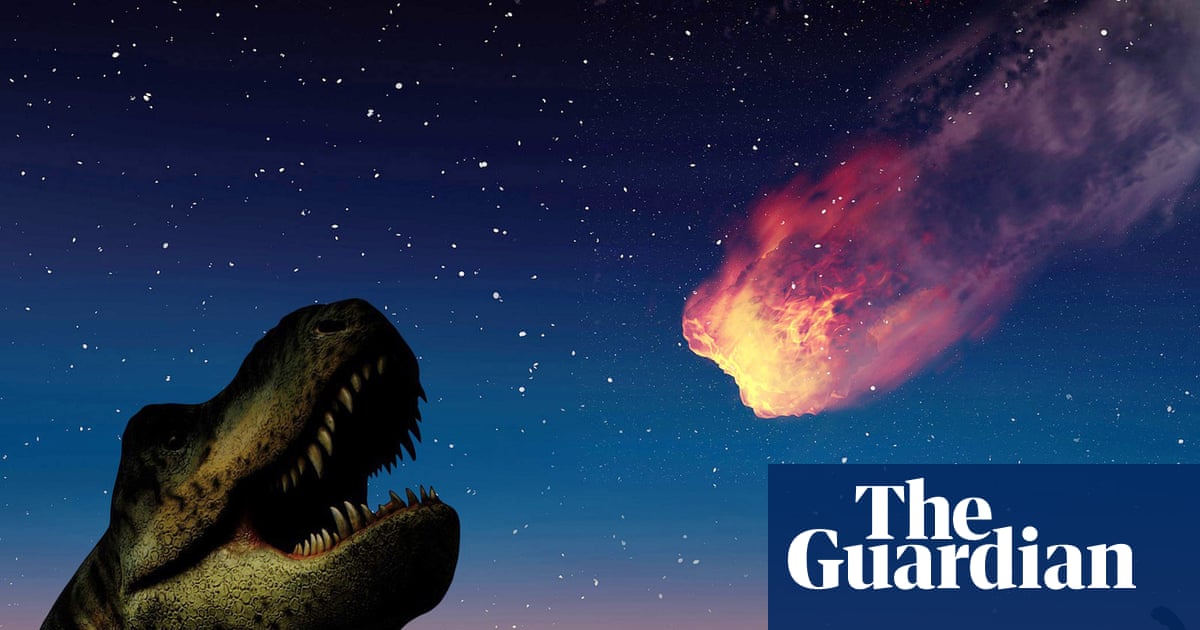Dinosaurs would not have become extinct had it not been for a catastrophic asteroid strike, researchers have said, challenging the idea the animals were already in decline.
About 66m years ago, during the late Cretaceous period, a huge space rock crashed into Earth, triggering a mass extinction that wiped out all dinosaurs except birds. However, some experts have argued the dinosaurs were already in decline.
Now researchers say the dating of a rock formation in New Mexico throws doubt on that idea, suggesting dinosaurs were thriving until the fateful impact.
Dr Andrew Flynn, the first author of the research at New Mexico State University, said: “I think based on our new study that shows that, at least in North America, they weren’t going towards extinction.”
Writing in the journal Science, Flynn and colleagues report how they dated a unit of rock called the Naashoibito Member in the San Juan basin using two methods.
The first involved analysing the ratio of two argon isotopes within crystals found in the rock, providing a maximum age for its formation. The second involved analysing the alignment of magnetic particles within material forming the rock – a feature that reflects the direction of Earth’s magnetic field at the time it was laid down.
Flynn said: “The extinction event actually happens essentially directly in the middle of a fairly short period of polarity [where Earth’s magnetic poles are] reversed.”
Taken together, the results suggest the section of the Naashoibito Member where the youngest dinosaur fossils have been found was formed, at most, about 350,000 years before the mass extinction. “These are the very last dinosaurs in southern North America,” Flynn said.
The team says the results suggest dinosaurs of that period were more diverse than previously thought. “There isn’t some uniform North American dinosaur fauna that made them really prone to extinction,” Flynn said.
Indeed, while there were some species common to the north and south of North America, including big predators such as T rex, there were also marked differences – something the researchers suggest reflects variations in climate.
Prof Steve Brusatte, a co-author of the study at the University of Edinburgh, said: “In the north there were lots of horned triceratops and standard duck-billed dinosaurs like edmontosaurus. But in the south there were duck-bills with elaborate crests and, most striking of all, there were enormous long-necked sauropods.”
He noted that one sauropod, alamosaurus, was almost 30 metres (100ft) long and weighed more than a Boeing 737.
“There is no sign that these dinosaurs were in any trouble, or that anything unusual was happening to them, or that they were in any type of long-term decline,” Brusatte said.
after newsletter promotion
Flynn said the perception that overall dinosaur diversity was falling before the asteroid hit could be a result of there being fewer exposed rocks, and hence fossils, dating to the end of the Cretaceous period than earlier in the epoch.
“It looks like, as far as we can tell, there’s no reason they should have gone extinct except for [the] asteroid impact,” he said.
Prof Michael Benton, at the University of Bristol, welcomed the study. The palaeontologist, who was not involved in the work, said: “The new evidence about these very late-surviving dinosaurs in New Mexico is very exciting, and shows in one locality at least that the faunas were diverse.”
But Benton noted the paper looked at only one location, not a representation of the complexity of dinosaur species at the time across North America, or all over the world.
“As the authors also show in the paper, in general dinosaurs of the last 6m years of the Cretaceous were less diverse, falling from 43 species beforehand to 30 species in western North America,” he said.
“We would suggest that there is evidence for overall declines in dinosaurs towards the end of the Cretaceous, with individual rich faunas where climates were favourable.”
First Appeared on
Source link













